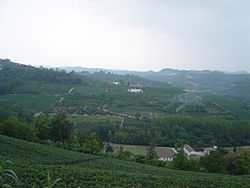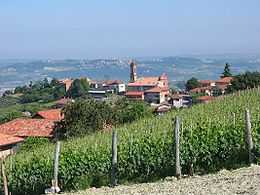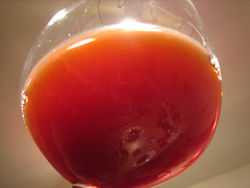Barbaresco

Barbaresco is an Italian wine made with the Nebbiolo grape. Barbaresco is produced in the Piedmont region in an area of the Langhe immediately to the east of Alba and specifically in the comunes of Barbaresco, Treiso and Neive plus that area of the frazione San Rocco Senodelvio which was once part of the comune of Barbaresco and now belongs to the comune of Alba. It was granted Denominazione di origine controllata (DOC) status in 1966 and Denominazione di Origine Controllata e Garantita status in 1980. The wine is often compared with Barolo-another Nebbiolo based wine from the Piedmont area. Though the wines do share many similarities, there are some distinct differences between them.
History
Historically the Nebbiolo grape was used to produce slightly sweet wines and while it gained fashion in the Turin and among members of the House of Savoy in the incarnation of Barolo, the Barbaresco style wine was always more obscure and less widely known. The sweet style common in Barbaresco was partially a product of circumstance though the fashion of European tastes at the time did prize some of the sweetness. The Nebbiolo grape tends to ripen late into October and temperatures in the region after harvest were cool enough to significantly slow down (or in some cases halt) fermentation. This process typically left the wine with noticeable amounts of residual sugar. In the 1890s, an enology professor in Alba was able to utilize a heated fermentation tank to achieve full fermentation of Barbaresco to a dry wine. After World War II, wineries in the area began to refocus on Barbaresco and increasing the reputation of the wine from outside the region. In the 1960s, the Gaja and Bruno Giacosa wineries began to market Barbaresco internationally with some success.[1]
Wine regions
The soils of Barbaresco zone are composed primarily of calcareous marl dating from the Tortonian epoch. The area is typically divided into three regions based on the principal towns of the area-Barbaresco, Neive and Treiso.[1] The soil and climate of the three areas are very uniform to each other which creates more across the board consistency than what would be found among the 11 communities in the Barolo zone.[2]
Barbaresco
The vineyards around the town of Barbaresco are responsible for 45% of the region's Barbaresco production with many of the area's largest wineries located in town. Wines from this area tend to be relatively light in color and body but very well structured and aromatic.[2]
Neive
In Neive, the Nebbiolo grape is fourth in plantings behind the cultivation of Barbera, Dolcetto and Moscato but this region is known for making some of the most powerful and tannic expressions of Barbaresco. The area is also home to the highly esteemed Nebbiolo vineyards of Santo Stefano and Bricco di Neive whose names are starting to appear on some single vineyard bottlings.[1] Located east of Barbaresco, Neive is responsible for 31% of Barbaresco's production and makes some of the most full bodied and tannic examples of the wine.[2]
Treiso

Located south of Barbaresco, with vineyards on the highest hilltop sites in the area, Treiso wines tend to be the lightest in body and are principally known for their finesse. A smaller area, Treiso accounts for 20% of the Barbaresco zone's production.[2]
Vineyard classifications
Beginning in the late 19th century, there have been attempts to classify the area's vineyards into Burgundian-like crus based on which areas produced the best wines. The Italian wine critic Luigi Veronelli created one such list in the 1960s and other writers and viticulturist attempted to create their own in the 1970s. Today many follow the lists compiled by the négociant based on which grapes are more highly priced based on performance. These lists typically include the Montefico, Montestefano and Rabajà vineyards in Barbaresco, the Albesani, Santo Stefano, Bricco di Neive and Gallina vineyards in Neive, and the Pajorè vineyard in Treiso.[1]
Wines

DOCG regulations stipulate that Barbaresco wines must be aged for a minimum of 2 years (at least 1 year in oak) prior to release and aged for at least 4 years to be considered a riserva. The wines must have a minimum 12.5% alcohol level though most wines are closer to 13.5%. Well-made examples of Barbaresco wines are expected to be aged at least 5 to 10 years after vintage before they are consumed, as they are extremely tannic and tight in their youth, and some continue to drink well even after 20 years. The typical style of a Barbaresco has bouquets of roses or violets with flavor notes of cherry, truffles, fennel and licorice.[1] As the wine ages, it can develop smoky notes and more earthy and animal flavors like leather and tar.[3]
Differences with Barolo
Despite being made from the same grape and produced in neighboring areas less than 10 miles from each other, the wines of Barbaresco and Barolo do have some distinct differences. Located south of the river Tanaro, the Barbaresco zone receives a slight maritime influence which allows Nebbiolo to ripen here a little earlier than it does in the Barolo zone. This allows the grape to get to fermentation earlier with a shorter maceration time. The early tannins in a young Barbaresco are not quite as harsh as Barolo and under DOCG rules it is allowed to age for a year less than Barolo. The Barolo wines that tend to be closer in body, fruitiness, and perfume to Barbaresco wines are generally the ones produced near the villages of La Morra and Barolo.[1] The most pronounced difference between the two wines is that the tannins of Barbaresco tend to soften quicker, which can make the wines more approachable to drink at an earlier age but won't allow it to age for as long as a traditionally made Barolo could. The smaller vineyard areas mean that annual production of Barbaresco is around 35% the production of Barolo and therefore the wines are not as widely available out on the market. However, the smaller area does generally produce more consistent profiles among the Barbarescos than across the more expansive Barolo zone.[2]
References
- Riconoscimento della denominazione di origine controllata e garantita del vino "Barbaresco": Disciplinare di produzione PDF (26.5 KB) regione.piemonte.it (Italian)
- Footnotes
- ↑ 1.0 1.1 1.2 1.3 1.4 1.5 J. Robinson (ed) "The Oxford Companion to Wine" Third Edition pg 62 Oxford University Press 2006 ISBN 0-19-860990-6
- ↑ 2.0 2.1 2.2 2.3 2.4 M. Ewing-Mulligan & E. McCarthy Italian Wines for Dummies pg 48-49 Hungry Minds 2001 ISBN 0-7645-5355-0
- ↑ H. Johnson & J. Robinson The World Atlas of Wine pg 161 Mitchell Beazley Publishing 2005 ISBN 1-84000-332-4
External links
| ||||||||||||||||||||||||||||||||||||||||||||||||||||||||||||||||||||||||||||||||||||||||||||||||||||||